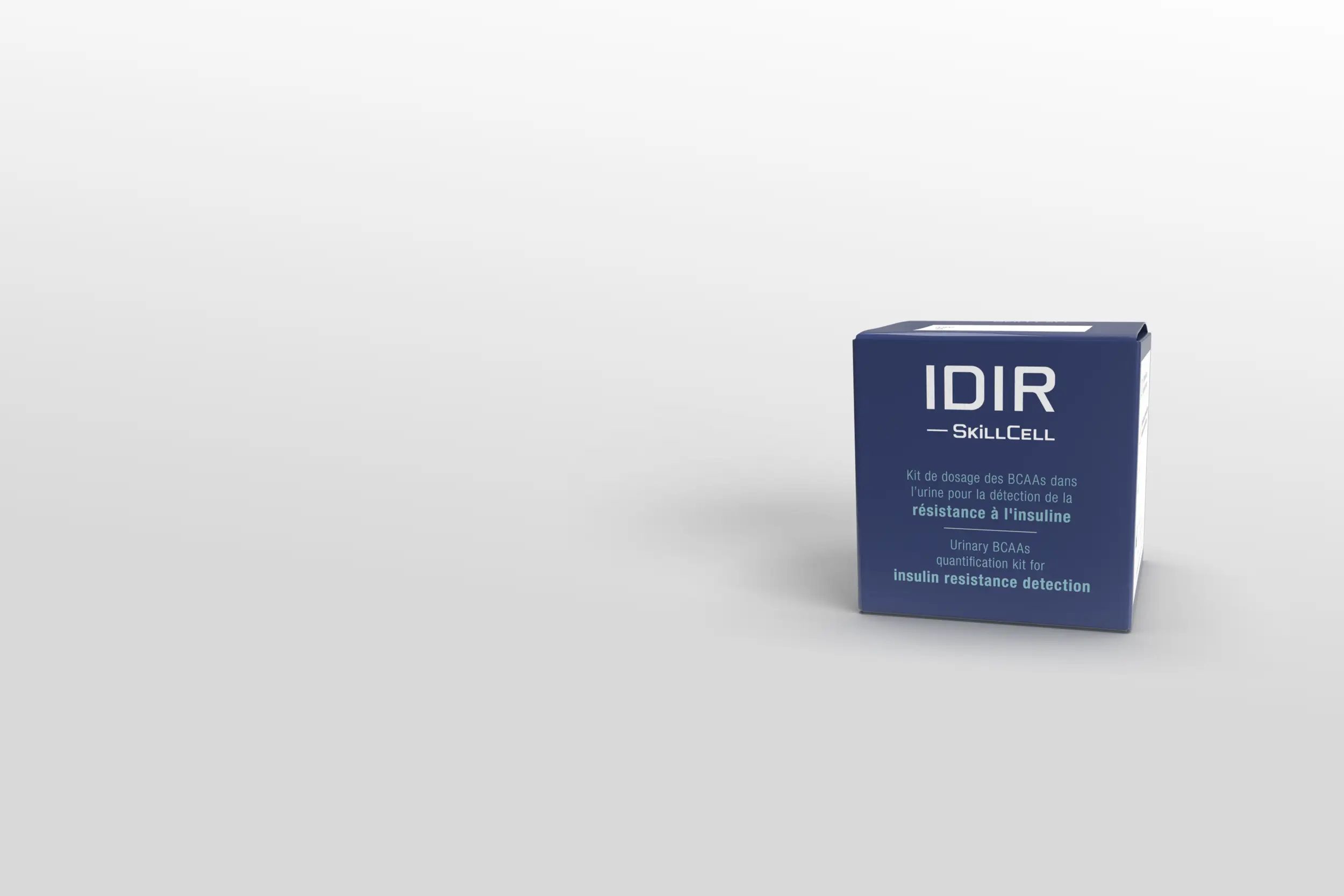IDIR®
Clinically validated, Sensitivity: 90,6% – Specificity: 69,0%.
IDIR®
The first CE-marked urine test for insulin-resistance identification

SkillCell develops and provides IDIR the first CE-marked urine test for insulin-resistance identification. IDIR meets high quality standards and require a light laboratory infrastructure.
SkillCell has developed IDIR, a colorimetric urine test detecting insulin resistance (IR) in 15 minutes. IR being strongly correlated to overweight and obesity, IDIR allows to alert on their critical impending health impacts and specially T2 Diabetes.
The first urine test for insulin-resistance
SkillCell has developed and patented(1) IDIR® (IDentification of Insulin Resistance), the first urine test to diagnose insulin resistance. Supported by a robust clinical study(2), IDIR® addresses the issue of overweight/obesity and metabolic disorders such as T2 Diabetes, major challenges in public health with very significant socio-economic implications.
IDIR®’s main indications:
- T2 Diabetes prevention,
- Anticipation of the consequences of obesity,
No more needle, blood sample or waiting time!
IDIR®’s mission is to provide people with transparent and critical health information, readily accessible, to help them manage their health and avoid the transition from insulin resistance to chronic metabolic diseases, while at the same time encouraging obesity management measures.
Insulin resistance: a key health information to combat a slow-motion disaster
Insulin resistance is a condition in which cells have a reduced capacity to respond to the insulin hormone. Insulin resistance is highly correlated to unhealthy dietary habits, sedentary life-styles and obesity. It is often an early condition that leads to chronic diseases such as T2 diabetes or NASH (non-alcoholic steatohepatitis) and their related complications. Insulin resistance is also a condition that can be reversed in a few months. Its diagnosis is therefore a powerful prevention tool for the chronic metabolic diseases mentioned above.
A dramatic global increase in Overweight/Obesity & Metabolic Disorders
Economic growth and modernization have led to lifestyle-related chronic diseases. Unhealthy dietary habits and the movement from active to sedentary lifestyles are dramatically increasing obesity and insulin resistance in the population, leading to diseases such as T2 diabetes or NASH. The onset of these pathologies is usually slow and difficult to determine, but their complications are extremely harmful and can absorb up to 20% of the entire healthcare budget of several countries, making it one of the biggest global health crises of the 21st century.
"Prevention is better than cure"
Several large-scale randomized controlled trials carried out in different countries confirm that prevention is efficient and cost effective to prevent overweight & obesity related chronic metabolic diseases such as T2 diabetes. Prevention actions include early diagnosis followed by lifestyle interventions, weight loss drug treatments, insulin and blood-glucose lowering drug treatments, etc. As an easy-to-use and cost-effective test, IDIR is an ideal solution for such prevention actions:
- Sensitive and specific: IDIR completed its proof of concept. It has demonstrated effectiveness compared to the HOMA reference standard test during the first phase of a clinical trial at the Montpellier University Hospital, including 330 people on arrival
- CE marked
- Cost-effective: low price
- Easy & Fast: Results in 15 minutes; color change
- Safe and biodegradable
References
-
(1) Urinary branched-chain amino acids (uBCAAs) as insulin resistance biomarkers, Patent n°EP22177090.2
-
(2) Santos Schneider, Francisco and Ouedraogo, Alimata and Fenech, Hugo and Baptiste, Julie and Picot, Marie Christine and Alali, Mellis and Mountou, Telma and Renard, Eric and Molina, Franck, Urinary Branched-Chain Amino Acids are New Biomarkers for Insulin Resistance Detection and Cardiometabolic Diseases Prevention. http://dx.doi.org/10.2139/ssrn.4210299